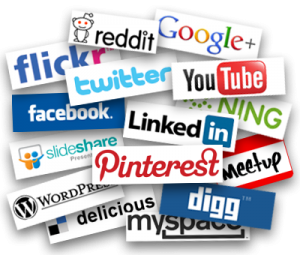 Whether we like it or not, the Internet, social media, and all of the related technology are here to stay. As evidenced every day in so many ways, this new technological landscape brings many wonderful benefits to our family’s lives and relationships. At the same time, as with any new innovations, this impact has a dark side.
Whether we like it or not, the Internet, social media, and all of the related technology are here to stay. As evidenced every day in so many ways, this new technological landscape brings many wonderful benefits to our family’s lives and relationships. At the same time, as with any new innovations, this impact has a dark side.
Though the study of the effects of social media on children is still relatively new, there is a growing body of evidence demonstrating what I will call the bad, the ugly, and the good (because I prefer to conclude this post on a positive note). I will describe some recent findings that are worth considering as you increasingly expose your children to different types of technology.
The Bad: Facebook Depression
There’s no doubt that Facebook is one of the most powerful forms of media for communication today. More than a billion users chat, share photos, and keep their friends and family up to date on their lives regularly. Yet, there is a dark side to its use, along with other forms of social media, that has been labeled Facebook Depression, though this phenomenon also includes anxiety, other psychiatric disorders, and a range of unhealthy behaviors.
Perhaps the most comprehensive study to date found that Facebook overuse among teens was significantly correlated with narcissism. Among young adults, Facebook overuse was also associated with Histrionic Personality Disorder, Antisocial Personality Disorder, Bipolar Disorder, and Sadistic, Passive-Aggressive, Borderline, Paranoid, and Somatoform Personality Disorders. This study also explored the strength of Facebook use as a predictor of these psychiatric disorders and found that, even when demographics, such as age, gender, median income, ethnicity, and education were controlled, Facebook use was one of the three strongest predictors.
An analysis of 15 studies found that increased media exposure, including television, movies, video games, and the Internet, was associated with violent behavior and isolation. It reported that children who watched violent shows were not only more likely to be more aggressive, but also to have fewer friends and to be more secluded socially. The researchers concluded that children who are aggressive will have fewer friends and be more likely to be bullies (because they are more aggressive) or victims of bullying (because they are isolated).
Another study of adolescent girls found that the more they used texting, instant messaging and other social media to discuss their problems, particularly romantic difficulties, the more depressive symptoms they presented. The researchers argued that the ease and frequency that technology affords children to communicate allows them to “co-ruminate,” that is, dwell on their problems without providing any solutions.
The Ugly: Internet Addiction
Addiction was the most widely used descriptor of the one-day moratorium on technology in the research I just described in a recent post. Internet addiction is commonly characterized as excessive use of the Internet that interferes with daily functioning and that can lead to distress or harm.
A review of research from the past decade has found that adolescents who demonstrated Internet addiction scored higher for obsessive–compulsive behavior, depression, generalized and social anxiety, attention deficit hyperactivity disorder, introversion, and other maladaptive behaviors. This research also revealed a interesting pattern of parental involvement. Those youth who were judged to have an Internet addiction rated their parents as lacking in love and nurturance, being over-invested, unresponsive, angry, and severe disciplinarians.
There is considerable debate within the mental-health field about whether dependence on technology is a true addiction, like alcohol, drugs, or gambling. In fact, the American Psychiatric Association, which produces the Diagnostic and Statistical Manual (think shrinks’ bible), decided not to include Internet Addiction in their latest revision. Some experts in the field argue that the unhealthy dependence on technology may be a symptom of some more fundamental pathology, such as depression or anxiety, and that so-called Internet addicts use technology to self-medicate and relieve their symptoms. Plus, unlike alcohol and drugs, Internet use doesn’t cause any direct physiological or psychological harm.
Despite this uncertainty in the psychological community, the students in the survey I wrote about in my last post made it clear that they believe Internet addiction is very real. It certainly passes the “duck test” (if it looks like a duck and sounds like a duck, it’s probably a duck). Not only did the students miss the functions that the technology offered, for example, texting, surfing the Web, and listening to music, but they actually craved the devices themselves. Said a English student, “Media is my drug; without it I was lost. I am an addict. How could I survive 24 hours without it?” Added an American student, “After experiencing this dreadful 24-hours, I realized that our obsession with media is almost scary. I could not even begin to imagine the world if it was media-free.”
So what specifically does Internet use provide to people such that it gets to the point of unhealthy behavior often associated with addiction? One study examined the types of gratification that people gain from the Internet and found that four specific forms of gratification were, cumulatively, most predictive of the tendency toward Internet addiction: virtual community (feeling connected to a group), monetary compensation (money they earned through various Web-based activities), diversion (distraction from their lives), and personal status (the feeling of individual standing they gained from Internet use). These types of gratification are normal for children, yet there is something about the Internet that morphs them into unhealthy needs that appear to become addicting.
This so-called addiction appears to go deeper than just psychological dependence. There is emerging evidence indicating that, for example, our interaction with technology produces the same neurochemical reaction—a burst of dopamine—as that found with alcohol, drug, sex, and gambling addictions. Persistent exposure to technology-related cues, such as the vibration from a smartphone announcing the arrival of a new text message or the ping of an incoming tweet, can cause people to get caught in a vicious cycle of dopamine stimulation and deprivation. Moreover, the brevity of technology, for example, 140-character text messages, lends itself to this vicious cycle because the information received isn’t completely satisfying, so people are driven to seek out more information for their next shot of dopamine. Imagine your children growing up with this relationship with technology and the strength of its grip on them if they are allowed ungoverned and unguided use of technology.
The Good: Social Media Can Help
Certainly, the research I’ve just described doesn’t paint a very rosy picture of the influence of technology on children. It’s not all bad though. Studies have shown that more time spent with social media is related to increased “virtual empathy,” meaning that expressed through technology, and “real-world empathy” (considered a related, but separate factor). The best predictor of virtual empathy was the time spent on Facebook and the use of instant messaging. More of both forms of empathy means more social support, always a good thing for children.
Social media can also help those young people who experience shyness or social anxiety. Introverted young people can gain comfort and confidence in social interactions in several ways. Shy children can use social media to overcome what is perhaps their most difficult challenge, namely, initiating new relationships, in a low-risk environment. They can avoid awkwardness that is endemic to making friends by allowing them to gain familiarity with others and build friendships online. Introverted children can also practice social skills with the relative distance and safety afforded by social media.
Technology may improve family relationships and encourage feelings of connectedness. First, technology can be used as a point of entry into children’s lives and create opportunities for sharing. Second, they enable families to have quality time and pursue activities of shared interest.
Social media can have educational benefits for children as well. They are learning practical skills that are necessary for success in today’s wired world. Specifically, children are learning how to use and become proficient with technology, developing their creative abilities, appreciating new and different perspectives, and enhancing their communication skills.
One study indicated that prosocial video games encourages helping behavior. The researchers found that young people were more likely to help others after playing a prosocial as compared to a neutral video game. In a related study, they observed that a similar effect when given the opportunity to protect a stranger who was being harassed.
Technology may even help children to better cope with stress in their lives. Technology can potentially mitigate stress is a number of ways. First, technology provides children with more outlets through which to express their feelings of stress, thus allowing a cathartic effect. Second, social media can provide children with social support which can act as a buffer against stressors. Technology, including Facebook postings and instant messaging, enables children to receive more, immediate, and diverse support from a wider range of people. Third, technology can allow children to find useful information that may help them to reduce their stress. Finally, technology may act as a distraction and a means of distancing children from the stressors, providing a respite from the stress and giving them the time and perspective to deal with the stress more effectively.
What Does This All Mean?
As I have often argued, technology is neither good nor bad, but, at the same time, it isn’t neutral either. The impact that technology has on your children depends not on the technology itself, but rather on how you educate them about it and the experiences they have with it. It is your responsibility to become informed about the potential benefits and costs of this new digital age and then make deliberate decisions about the type and quantity of technology you expose your children to.






